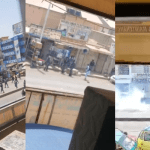Floods have caused havoc in Kinshasa, the Democratic Republic of the Congo’s capital, with water flowing into homes and citizens traversing waterlogged roadways by boat.
The overflowing Congo River, which runs across much of the country, has also flooded areas outside of the capital.
The massive, essential river has reached its highest level in more than six decades.
Floods have killed more than 300 people in recent months, according to officials.
Residents in the impoverished megacity of Kinshasa reported how schools, hospitals and churches have been washed away.
Kinshasa is home to several small rivers and streams, which often double as open sewers. Many have now overflown.
A man plunged through thigh-level water on one flooded street, towing a canoe full of passengers behind him. Trucks navigated the same waters with caution, while dozens of discarded bottles floated on the top.
The RVF, the body in charge of DR Congo’s waterways, issued an alert in late December.
It warned of “exceptional flooding” in the Kinshasa area due to heavy rains.
Provinces like Mongala and Ituri had already experienced severe flooding by this period.
In Kinshasa, flooding is common but this year the River Congo has risen just shy of 6.26 metres, the level reached during record flooding in 1961.
Further upstream, in the city of Kisangani, the mayor said that over 200 houses have been submerged.
The Congo River has also caused turmoil in Congo-Brazzaville, a nation that borders DR Congo.
Flooding there has impacted more than 336,000 people and 34 health facilities, the World Health Organization said on Thursday.
Many factors contribute to flooding, but a warming atmosphere caused by climate change makes extreme rainfall more likely.
Just over a year ago, floods in Kinshasa left more than 120 people dead.














